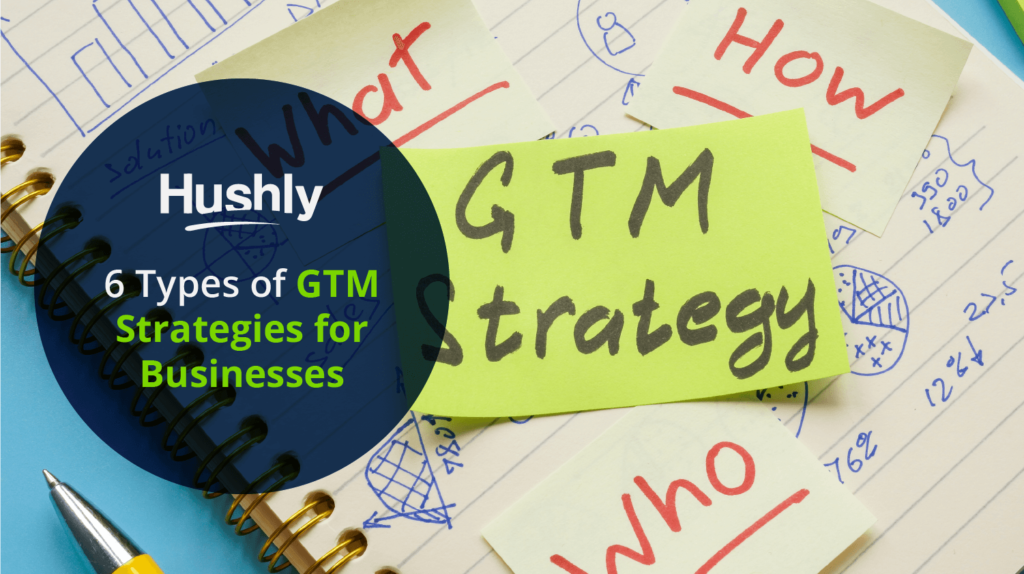Maybe your company is releasing a product completely different from anything you’ve released. Perhaps you’re entering a market you’re not experienced in and hoping to convert customers you’re not used to talking to.
In either case, you could be unsure how to market yourself and get the revenue flowing quickly.
The faster you can figure it out, the better it will be for your company. This makes the pressure to get it right the first time seem overwhelming.
To help, we’ve compiled this guide which includes six go-to-market strategies to get started.
Each strategy is designed to be flexible and generic to fit any industry or niche. We’ll explain the key terms involved and suggest ways to apply these go-to-market strategy steps immediately.

What is GTM?
Your go-to-market strategy is the motion your company makes whenever it hopes to enable a new revenue stream.
Any time you are making a foray like this, you’ll want to have a strategy in place which helps you:
- Identify key people (buyers, executives, points of contact).
- Identify market soft spots that you can move in on.
- Identify companies to work with.
- Determine and execute marketing and sales strategies.
We recommend picking a go-to-market strategy template like the one below and reiterating it over time.
Here are six types of GTM strategies for you to draw inspiration from.
1. Inbound
An inbound go-to-market strategy framework uses content marketing to attract customers and drive conversions. This up-front value generates demand and leads to conversions.
Inbound GTM strategies will require a diverse array of content, which can include:
- SEO Blogs
- Social Media Posts
- Whitepapers
- Case Studies
- Podcasts
- Videos
Each piece of content serves a dual purpose: to entertain and educate.
Creating valuable content without asking for anything in return is the simplest way to earn a customer’s trust and build authority simultaneously.
You should use an inbound GTM strategy:
- If you hope to build a reputation as a topic authority or become an industry thought leader.
- If you can make short-term investments in content creation and are ready to be patient for results.
- If you sell a product that won’t change fundamentally over time. For example: if you run a construction firm, a blog about choosing a specific type of roof for a metal garage will be valuable today and five years from now.
2. Product
If you have a ton of confidence in your product, you can build massive trust and authority by letting it speak for itself.
This means you must have a product capable of marketing, facilitating purchases, tracking customer behavior, conducting analytics, and receiving feedback all on its own.
This kind of GTM strategy reduces the pressure on sales and marketing but requires a robust product offering that must be constantly monitored and updated as you go.
A Product-Led GTM strategy is right when:
- Your product is robust and has many uses, potentially even ones you haven’t thought of yet.
- You have a team of talented workers ready to make significant changes to the product on the fly.
- You have a product that you know is powerful but haven’t determined the best audience for it yet. A product-led GTM will allow customers to get to know your product and determine its best use.
- You sell freemium-model software or other products that scale quickly and easily and generate massive value over time.
3. Sales
A sales-led GTM motion will pressure your sales team to drive conversions using their skill.
Your product is obviously important here, but it won’t be the center of the show. Instead, you’ll focus on supporting your sales team by positioning your product and company as good value investments via outbound content like emails and paid leads.
Sales-led GTMs work best when:
- Your product requires long sales cycles but produces high-margin sales.
- Your product is not necessarily superior. This could be because you’re already entering a very competitive or saturated market.
- Your product is complicated. This will make it harder for customers to quickly grasp the value and necessitate skilled salespeople to overcome many objections.
4. Demand Generation
With demand generation, your primary marketing goal will be to generate high-quality leads that convert more often.
In some respects, it’s the opposite of a sales-led GTM. This is because a demand generation campaign will focus on creating leads that aren’t difficult to convert. They should arrive warm, with good knowledge of your product and a healthy interest level.
To achieve this, you’ll use any mixture of inbound and outbound marketing strategies to create high-quality leads. Think content marketing, email campaigns, and paid leads.
Focus on demand generation if:
- You aren’t sure who your best customers will be just yet. Widescale demand generation techniques will reveal who and where to market yourself to.
- You want to decrease pressure on your sales team by delivering better leads that convert more often.
- You hope to spread awareness of the type of product you offer. This could be because your product is so new or has no direct competitor.
5. Account-Based
Account-based go-to-market strategies utilize 1:1 marketing tactics aimed at single companies or buyers.
Rather than casting a wide net, you’ll sharpen your harpoon and go after the biggest whales you can find.
This means orienting all teams toward building personal relationships, identifying decision-makers, and creating marketing content for specific buyers.
Account-based marketing GTMs are good for:
- Companies looking to market their products to a small group of high-margin buyers.
- Companies selling products that don’t require a lot of sales to succeed. These would be high-margin products with long sales cycles that deliver massive value over time.
- Companies who see relationship-building as more valuable than short-term sales opportunities. These companies want to grow alongside their buyers and align themselves toward mutual goals.
6. Channel Specific
Our last go-to-market strategy example is channel led. A “channel” in this context means a sales channel such as retail, ecommerce, social media shopping, etc.
A channel-led GTM focuses on building up a particular sales and marketing channel rather than focusing on any particular product or marketing technique.
This entails forming relationships with important people within the channel, building influence there, then launching products that benefit the channel and your company.
Example: you could offer a product that promises to help people build social media followings. In this case, it’s best for you to focus on building up these channels to make your product more valuable through its growth.
How Hushly Can Help With Any GTM Campaign
Regardless of what product you’re marketing, you’ll want customers to feel like they can go to you with questions.
You’ll want a robust website that welcomes prospects, directly addresses them, and is capable of capturing lead information accurately. Customer analytics will also help you identify how your GTM strategy works and what needs to be adjusted.
Hushly’s platform can do all of this for you, freeing you to focus on developing products and relationships that will help your company grow.
Check out our free eBook, A Go-to-Market Perspective, to learn more about formulating and executing a powerful GTM strategy.


